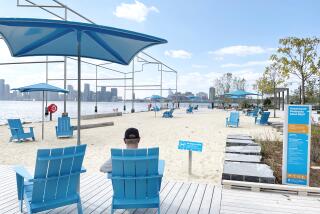Harboring a Vision for a City ‘Jewel’
- Share via
NEW YORK — Governors Island is a place of paradoxes, a 172-acre island just a five-minute ferry ride from Manhattan that was off-limits to ordinary New Yorkers for more than two centuries.
Dutch settlers purchased Governors Island in 1637 from the Lenape Indians for two ax heads, a couple of nails and a string of beads. President Bush sold the former military base to the city and state in 2003 for $1.
If the island was a bargain both times, it has become something more -- a centerpiece for the renewal of New York’s harbor.
The New York state agency that was put in charge of developing the island is scheduled to deliver its master plan in fall 2005.
Architects, urban planners and community groups gathered on the island in June for a workshop to consider scenarios, and in late July, the Governors Island Preservation and Education Corp. held its first public meeting about the island’s future.
“It is a jewel for New York,” Randy A. Daniels, the agency’s chairman and New York’s secretary of state, said recently. “It is a once-in-a-century opportunity to do something spectacular.”
The focus on the island is part of the transformation of the harbor.
In the last six years, major portions of Manhattan’s Hudson River waterfront have been turned into parkland, with playgrounds, athletic fields, kayaking, community gardens, an ecology center and even a trapeze school. The Staten Island Ferry’s Manhattan terminal is being rebuilt, and its counterpart across the harbor is being renovated.
Planning is underway in Brooklyn for a 67-acre park along the East River with shops, galleries, restaurants and perhaps a hotel and marina. A new terminal for cruise ships is being designed.
Because of the location of Governors Island -- half a mile off the southern tip of Manhattan -- planners say it is unique.
“The vision is it will be a place of rest, relaxation, recreation and education,” Daniels said.
The vision, planners agree, requires preserving the island’s character and history.
“It is like a little time capsule,” said Robert Pirani, director of the Governors Island Alliance, a coalition of civic, business and preservation organizations. “It also is a unique lens to look back at New York and the nation.”
In 1524, Giovanni da Verrazano, an Italian exploring for the French, sailed into the bay and viewed the ice cream cone-shaped island. In the years after the Dutch purchase, it was a quarantine station and fortresses under Britain and the United States, which ultimately assumed control.
Several major Army facilities were headquartered on Governors Island until it was turned over to the Coast Guard in 1966. About 800 Coast Guard families lived there until the facility was closed in 1997.
President Reagan and Soviet President Mikhail S. Gorbachev discussed disarmament at a 1988 summit on the island. The United Nations sponsored negotiations there five years later on returning Haiti’s ousted president, Jean-Bertrand Aristide, to power.
Except for organized tours, caretakers, a small cadre of planners and wildlife -- including a pair of pheasants -- the island has been deserted. An abandoned swimming pool, bowling alley, movie theater and Burger King stand as reminders of the past. Clusters of historic homes remain empty.
“In the midst of Gotham you had this Mayberry,” Pirani said. “You had all these people living their lives and raising their kids in this bucolic village.”
Twenty-two acres, including two historic forts, were designated a national monument by President Clinton in 2001 and are managed by the National Park Service.
Planning for the remaining 150 acres is the mandate of the Governors Island Preservation and Education Corp., whose board of directors is appointed by Gov. George E. Pataki and Mayor Michael R. Bloomberg.
Both leaders agree that the island should be turned into a “grand civic space,” with the right mix of tenants.
To capitalize on its closeness to Wall Street, preliminary plans include a world-class conference center and hotel. Discussions are underway with developers, and talks also have begun with museums and several universities to shift facilities, possibly including an honors program or a supercomputing center, to the island.
The U.N. has been approached, as has the Geneva-based World Economic Forum, which holds an annual gathering of political and business leaders.
Possibilities include a national art academy, a culinary school and institutes focusing on economics, architecture and design. A training center geared to the nearby financial community is being studied.
“The challenge is to find components that will make it possible, as soon as possible, for the island to pay its own way,” said James Lima, president of the Governors Island Preservation and Education Corp.
Under the terms of the federal government’s transfer agreement, permanent housing, a casino that was proposed by Rudolph W. Giuliani when he was mayor and power plants -- except for the island’s use -- are prohibited. Parking is restricted.
Lima said private cars would be banned from the island, which will have extensive parkland and possibly a marina and beach.
“We want to be part of Manhattan with no cars,” he said.
Daniels said he expected a master planner to be appointed by the end of the year and envisioned an international design competition for some of the new facilities.
“The challenge is to make sure New York and the nation understands the opportunity that is here and makes the most of it,” Pirani said. “There are not that many 172-acre islands in New York.”
More to Read
Sign up for Essential California
The most important California stories and recommendations in your inbox every morning.
You may occasionally receive promotional content from the Los Angeles Times.










